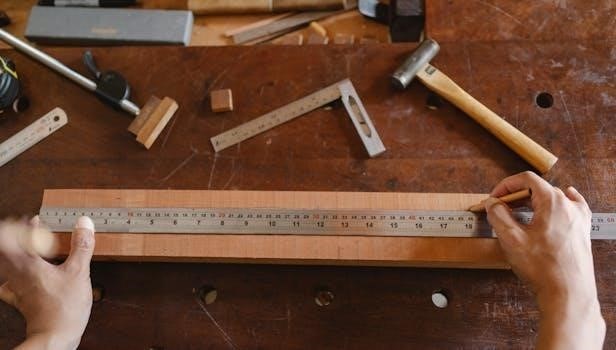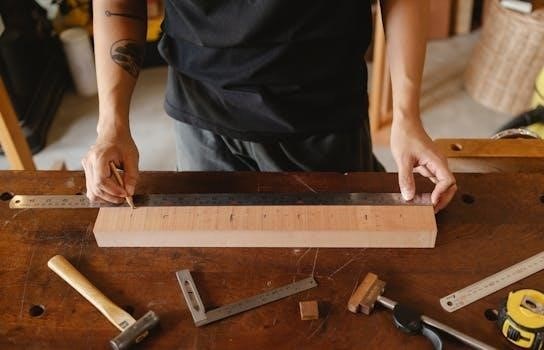The Roubo workbench, a French design gaining popularity, offers a stable and portable work platform․ Its construction is relatively quick and inexpensive, making it an attractive option․ This design is a timeless centerpiece for any workshop․
Origins of the Roubo Workbench
The Roubo workbench traces its roots back to the 18th century, a period when workrooms often shared space with living areas․ This design is credited to André Jacob Roubo, a French carpenter and author who detailed it in his renowned book, L’Art du Menuisier․ Roubo’s design was not just a functional piece of furniture, but a testament to the craftsmanship of the era, where a workbench would not be out of place even in the front room․ The design reflects a time when work and life were more intertwined, and furniture was built to last and serve multiple purposes․

Key Features of the Roubo Design
The Roubo workbench is characterized by its robust construction, often featuring a thick, solid slab top and mortise and tenon joinery․ These elements contribute to its exceptional stability and longevity․
The Slab Top Construction
The hallmark of a Roubo workbench is its substantial slab top, typically crafted from a thick, solid piece of hardwood․ This design choice provides an incredibly stable and flat work surface, ideal for a variety of woodworking tasks․ The substantial top can be made from several boards joined together edge to edge, or from one solid piece; The thickness of the slab contributes significantly to the overall weight and stability of the bench, minimizing movement during heavy work․ A properly constructed slab top is crucial for achieving precise and accurate results․ The surface should be flat and true, allowing for consistent clamping and referencing of workpieces․
Mortise and Tenon Joinery
Mortise and tenon joinery is a fundamental aspect of the Roubo workbench’s robust construction․ This traditional woodworking technique involves creating a mortise (a hole or recess) in one piece of wood and a tenon (a projecting tongue) on another, which then fit together to form a strong and secure joint․ The Roubo design frequently uses large, timber-frame sized mortise and tenon joints to connect the legs and aprons․ This technique provides exceptional strength and durability, ensuring the workbench can withstand the rigors of daily use․ Scaling these joints correctly is crucial for the overall stability and longevity of the bench․ Properly executed mortise and tenon joints create a solid and reliable framework․

Materials and Dimensions
Building a Roubo workbench requires hardwood lumber, with options like hard maple, ash, or oak․ Dimensions vary, but a typical bench is about 87″ long, 24″ wide, and 35″ high․
Recommended Wood Species
Selecting the right wood species is crucial for a robust Roubo workbench․ Hardwoods are generally preferred due to their strength and durability․ Maple is a popular choice, known for its hardness and resistance to wear․ Ash is another good option, offering a balance of strength and workability․ Oak, while durable, may have more sapwood and require more volume․ Some builders may opt for cherry or walnut for accent pieces, adding visual appeal․ When choosing your wood, consider both the functional and aesthetic aspects of your workbench, ensuring it can withstand the rigors of woodworking while also looking great in your shop․
Typical Workbench Dimensions
Roubo workbenches typically have a length around 1․5 to 2․2 meters, or 60 to 87 inches․ The width is often between 50 to 60 centimeters, or 20 to 24 inches, though some may choose a narrower 18․5 inch width based on available materials․ The height is usually around 86 to 90 centimeters, or 34 to 35 inches, but is often customized to suit the builder’s height․ The top thickness is generally around 4 inches․ These dimensions are guidelines and should be adjusted for specific needs․ The workbench’s weight, especially with hardwood, can exceed 300 pounds․
Building Process
The construction involves scaling joinery for a robust frame․ Base assembly is crucial, and this includes creating a flat, stable top․ Following plans ensures a successful build․
Scaling Joinery for a Robust Frame
Creating a sturdy Roubo workbench necessitates precise scaling of joinery․ This involves adapting mortise and tenon sizes to the timber’s dimensions․ For a timber-frame style, scaling up is essential․ These joints must withstand heavy use․ Proper scaling guarantees the frame’s integrity, preventing wobbling and ensuring stability․ Three different timber-frame-sized mortise and tenons should be considered․ The joinery should be done with care, as this step is vital for the workbench’s longevity․ A well-scaled frame ensures a reliable and solid foundation for your workbench․ This is a key step for a long-lasting workbench․
Assembling the Base
Assembling the Roubo workbench base involves connecting the legs and aprons using the scaled joinery; Ensure all mortise and tenon joints are fitted tightly․ Begin by joining the legs to the aprons, creating the frame’s perimeter․ Clamps will be necessary to hold pieces firmly while the glue dries․ Accuracy is essential in this stage for the base to be square and level․ This base forms the foundation of the workbench so a solid construction is vital․ Once the frame is assembled, ensure it is stable before proceeding to the next steps․ This step is important for the overall workbench stability․

Variations and Modifications
The classic design can be adapted to suit different needs․ Modifications include split-top designs and hybrid benches, like the Roubo-Nicholson․ These variations offer unique features and functionality․
The Split-Top Roubo Design
The Split-Top Roubo workbench is a modern adaptation of André Roubo’s original design, inspired by his plate 11․ This version introduces a gap in the middle of the bench top, offering several advantages․ This split allows for clamping items vertically, and it also provides space for specialized jigs or tool storage․ It is a versatile and functional twist on the classic, suitable for both hand tool and power tool users․ The split top is a time-tested design, meant to last a lifetime and never need replacing․ This modification addresses the needs of contemporary woodworkers while still adhering to the robust spirit of the Roubo design․
Hybrid Roubo and Nicholson Benches
The hybrid approach combines elements of both the Roubo and Nicholson workbench designs, resulting in a unique and versatile work surface․ This fusion often incorporates the heavy, slab-like top of the Roubo with the narrower legs and apron system of the Nicholson․ The resulting bench aims to balance the mass and stability of a Roubo with the accessibility and efficiency of a Nicholson․ This hybrid can be tailored to individual needs and preferences, offering a practical solution for those seeking specific features from both styles․ This often results in a bench that is both robust and practical for various woodworking tasks․

Vises and Accessories
Integrating vises is crucial for a functional workbench, with various options like face vises offering substantial clamping width and depth․ These essential additions enhance the versatility of the Roubo design․
Integrating Vises into the Design
The integration of vises into a Roubo workbench is paramount for its functionality, allowing for secure clamping of workpieces․ The design often accommodates face vises, which provide substantial clamping width and depth, surpassing many standard options․ The maximum clamping width can reach 220 mm, with a clamping depth of 270 mm, offering a robust hold for various tasks․ The vise’s placement and method of attachment are carefully considered during the design process to ensure optimal performance and accessibility․ This is usually done during the bench building process to customize the placement according to preference․ The selection and integration of vises are crucial to the overall utility of the Roubo workbench․
The enduring appeal of the Roubo workbench lies in its robust design, offering a sturdy and versatile platform․ It is a timeless piece that can be a centerpiece in any workshop․
The Enduring Appeal of the Roubo Workbench
The Roubo workbench, with its 18th-century French origins, continues to captivate woodworkers due to its robust and timeless design․ Its slab top and mortise and tenon joinery provide exceptional stability, making it suitable for both hand and power tool work․ The design’s adaptability allows for various modifications, such as the split-top or hybrid versions․ The Roubo workbench is more than just a work surface; it is a statement of craftsmanship․ Its simple yet sturdy construction makes it a reliable platform that can be built quickly and inexpensively․ Its enduring appeal stems from its blend of functionality and the classic aesthetic, ensuring its place in workshops for years to come․